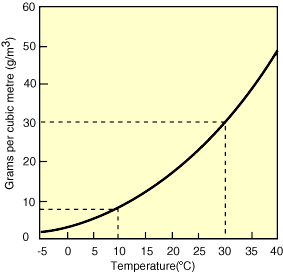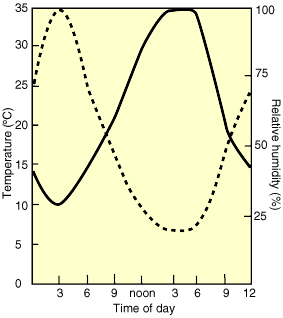[FONT=Arial, Helvetica, sans-serif][/FONT]
[FONT=Arial, Helvetica, sans-serif]I thought i would add definitions for humidity as taken off the Australian governement website. I hope they dont mind. This will clarify what humidity we are talking about.[/FONT]
[FONT=Arial, Helvetica, sans-serif]Humidity Definitions[/FONT]
[FONT=Arial, Helvetica, sans-serif]Humidity is essentially the number of water vapour molecules in the air, but there are many and varied ways of expressing it. All of these terms are used scientifically, but humidity figures provided for public use in newspapers are usually relative humidity.[/FONT]
[FONT=Arial, Helvetica, sans-serif][SIZE=-1]
Figure 2
Change in amount of water vapour in saturated air with temperature.
The air's capacity for water vapour increases as air temperature increases.
Air with a temperature of 30°C can hold more than three times
as much water vapour as air at 10°C.[/SIZE][/FONT]
[FONT=Arial, Helvetica, sans-serif]
Absolute humidity [/FONT][FONT=Arial, Helvetica, sans-serif]
[/FONT][FONT=Arial, Helvetica, sans-serif]The mass of water vapour in a unit volume of air. It is a measure of the actual water vapour content of the air.[/FONT]
[FONT=Arial, Helvetica, sans-serif]
Specific humidity[/FONT][FONT=Arial, Helvetica, sans-serif]
The mass of water vapour per unit mass of air (including the water vapour). It is another measure of the actual water vapour content of the air.[/FONT]
[FONT=Arial, Helvetica, sans-serif]
Mixing ratio[/FONT][FONT=Arial, Helvetica, sans-serif]
The mass of water vapour per unit mass of dry air (excluding the water vapour). Another measure of the actual water vapour of the air.[/FONT]
[FONT=Arial, Helvetica, sans-serif]
Vapour pressure[/FONT][FONT=Arial, Helvetica, sans-serif]
The partial pressure of the water vapour. Yet another measure of the actual water vapour content of the air. (Air pressure is the sum of the partial pressures of the gases comprising the air.)[/FONT]
[FONT=Arial, Helvetica, sans-serif]
Saturation[/FONT][FONT=Arial, Helvetica, sans-serif]
The air is saturated with water vapour when it holds as much water vapour as it can at that temperature.[/FONT]
[FONT=Arial, Helvetica, sans-serif]
Saturated vapour pressure[/FONT][FONT=Arial, Helvetica, sans-serif]
The water vapour pressure when the air is saturated.[/FONT]
[FONT=Arial, Helvetica, sans-serif]
Dew-point
The temperature to which air must be cooled (at constant pressure and constant water vapour content) for saturation to occur.[/FONT]
[FONT=Arial, Helvetica, sans-serif]
Frost point[/FONT][FONT=Arial, Helvetica, sans-serif]
When the dew-point falls below freezing it is called the frost point.[/FONT]
[FONT=Arial, Helvetica, sans-serif]
Wet-bulb temperature [/FONT][FONT=Arial, Helvetica, sans-serif]
In simple terms, the lowest temperature to which air can be cooled by evaporating water into it.[/FONT]
[FONT=Arial, Helvetica, sans-serif]
Relative humidity (RH)[/FONT][FONT=Arial, Helvetica, sans-serif]
The ratio of the actual amount of water vapour in the air to the amount it could hold when saturated expressed as a percentage
OR the ratio of the actual vapour pressure to the saturation vapour pressure expressed as a percentage.[/FONT]
[FONT=Arial, Helvetica, sans-serif]The amount of water vapour the air can hold increases with temperature. Relative humidity therefore decreases with increasing temperature if the actual amount of water vapour stays the same.[/FONT]
[FONT=Arial, Helvetica, sans-serif]
[/FONT]
[FONT=Arial, Helvetica, sans-serif][SIZE=-1]
Figure 3
Relative humidity varies significantly when the temperature changes,
even when the actual amount of water vapour in the air remains the same.[/SIZE][/FONT][FONT=Arial, Helvetica, sans-serif][SIZE=-1]
Temperature ________
[/SIZE][/FONT][FONT=Arial, Helvetica, sans-serif][SIZE=-1]
Relative Humidity[/SIZE][/FONT][FONT=Arial, Helvetica, sans-serif][SIZE=-1]
_ _ _ _[/SIZE][/FONT][FONT=Arial, Helvetica, sans-serif]
[/FONT]
[FONT=Arial, Helvetica, sans-serif]
Relative humidity[/FONT]
[FONT=Arial, Helvetica, sans-serif] =
[/FONT]
[FONT=Arial, Helvetica, sans-serif][SIZE=-1]The actual amount of water vapour in the air x 100%[/SIZE][/FONT]
[FONT=Arial, Helvetica, sans-serif][SIZE=-1]The amount of water vapour required to saturate the air at that temperature [/SIZE][/FONT]
[FONT=Arial, Helvetica, sans-serif]OR[/FONT]
[FONT=Arial, Helvetica, sans-serif][SIZE=-1]The actual vapour pressure x 100%[/SIZE][/FONT]
[FONT=Arial, Helvetica, sans-serif][SIZE=-1]The saturated vapour pressure at that temperature[/SIZE][/FONT]





